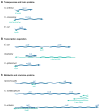Bacterial antisense RNAs: how many are there, and what are they doing?
- PMID: 20707673
- PMCID: PMC3030471
- DOI: 10.1146/annurev-genet-102209-163523
Bacterial antisense RNAs: how many are there, and what are they doing?
Abstract
Antisense RNAs encoded on the DNA strand opposite another gene have the potential to form extensive base-pairing interactions with the corresponding sense RNA. Unlike other smaller regulatory RNAs in bacteria, antisense RNAs range in size from tens to thousands of nucleotides. The numbers of antisense RNAs reported for different bacteria vary extensively, but hundreds have been suggested in some species. If all of these reported antisense RNAs are expressed at levels sufficient to regulate the genes encoded opposite them, antisense RNAs could significantly impact gene expression in bacteria. Here, we review the evidence for these RNA regulators and describe what is known about the functions and mechanisms of action for some of these RNAs. Important considerations for future research as well as potential applications are also discussed.
Figures


References
-
- Argaman L, Hershberg R, Vogel J, Bejerano G, Wagner EGH, et al. Novel small RNA-encoding genes in the intergenic regions of Escherichia coli. Curr Microbiol. 2001;11:941–50. - PubMed
Publication types
MeSH terms
Substances
Grants and funding
LinkOut - more resources
Full Text Sources
Other Literature Sources

